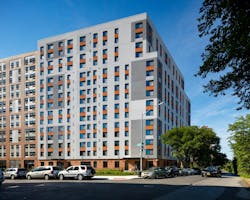Multifamily Housing Meets Passive House Design
Sustainability and affordability are often competing priorities—or at least are often seen that way. But Curtis + Ginsberg Architects (C+GA) has shown that doesn’t have to be the case, particularly when it comes to multifamily housing. In recognition, the Ivory Prize, which honors innovations in affordable housing, recently named the New York firm a co-winner of the 2021 Ivory Prize for construction and design.
C+GA achieves both sustainable and affordable multifamily housing through passive house design principles—such as a well-insulated building envelope and highly efficient windows and mechanicals—that reduce long-term operational costs.
“Our clients basically own the buildings forever,” says Mark Ginsberg, principal, C+GA. So even modest monthly energy savings can have a significant impact over many years.
“It’s really about long-term affordability,” says Crystal Ng, director of sustainability, C+GA.
Completed in 2019, C+GA’s 154-unit Park Avenue Green is currently the largest affordable multifamily passive house building in North America. With rooftop photovoltaic panels that provide 25 percent of the building’s electricity, Park Avenue Green is expected to save up to $7.5 million in energy costs over its first 10 years of operation, compared to existing New York City housing stock, according to C+GA.
Sustainability and affordability have been dual goals for C+GA since its start in 1990. More recently, it has achieved those goals through passive house design, finishing nine passive house projects over the last eight years, including five multifamily buildings—plus two passive house projects currently in construction and another seven in design. The firm first used passive house on four single family homes rebuilt after the 2012 destruction of Hurricane Sandy.
Over the years, C+GA has learned there’s more than one way to make a passive house structure and still meet the passive house certification requirements.
For example, C+GA’s first large-scale passive house building, Beach Green Dunes I in Queens, completed in 2016, and Beach Green Dunes II, completed by another contractor two years later, each have a different envelope, ventilation system, and heating and cooling system. But their energy consumption levels are almost identical.
“They look very similar, but what’s interesting is every system in each building is different,” Ginsberg says. The takeaway: “how you design it and what systems you use can vary greatly, and you can get the same results.”
C+GA has learned to take a nimble approach to passive house. At Park Avenue Green, each apartment has its own energy recovery ventilator (ERV) unit for heating and cooling. But during design, C+GA realized the unitized ERVs would introduce the risk of condensation as their ducts touched the outside CMU walls. So C+GA instead positioned the ducts through aerated concrete blocks with a higher R-value than the CMU wall—mitigating the potential for condensation.
A nimble approach to passive house design
A nimble approach also means C+GA can adjust to its various clients’ needs while still meeting its efficiency goals. Because each Park Avenue Green apartment has its own ERV unit, maintenance staff have to enter each apartment a couple of times a year to clean the unit—an intrusion that residents often don’t like. So, in some of its later multifamily passive house projects, C+GA uses a centralized, rooftop ERV.
While passive house keeps long-term operational costs low, it does incur higher upfront costs, Ginsberg notes. Passive house’s added costs have dropped from about 8 percent to around 3 to 4 percent, he notes: “We’re slowly getting it down.”
C+GA’s process efficiencies have helped. For instance, if C+GA plans to install 400 windows, it first performs a blower-door test with just one window installed. “If there’s a problem with the first window, we work with it until it passes the test, and then we know what to do with the other 399,” Ginsberg says.
The growing popularity of sustainable design has also helped with pricing and sourcing, he notes. “It’s getting easier and easier to find the products one needs to meet passive housing as more and more European manufacturers are coming over and doing testing to make sure they meet US standards.”
Passive house design might become even more popular among New York builders as they aim to meet the city’s ambitious targets of 100 percent carbon-free electricity by 2040 and carbon neutrality by 2050. With that in mind, C+GA has been moving toward all-electric design.
It’s not only multifamily building owners who benefit, Ginsberg notes. Passive house also delivers greater comfort to the residents. Passive house buildings exhaust stale inside air and bring in fresh outside air. With a low U-factor, their windows keep out the heat, cold, and drafts. And their well-insulated, well-sealed walls create a sense of quiet—a rare feature in multifamily housing.
To see if residents are in fact as satisfied with the buildings as C+GA expects, the firm plans to use part of its $40,000 Ivory Prize award to conduct post-occupancy surveys.

